Property from a Private Collection, Tokyo Toshimitsu Imai Lava 1957 oil on canvas 44 7/8 x 64 3/4 in. (114 x 164.5 cm) Signed and dated "IMAÏ俊 [Toshi] OCTOBRE 1957 一九五七年拾月 [1957 October] 今井俊満作 [By Imaï Toshimitsu]" on the reverse.
Provenance Galerie Stadler, Paris Collection Rodolphe Stadler, Paris Acquired from the above by the present owner Exhibited Paris, Galerie Stadler, IMAÏ, February 23 - March 16, 1957 Osaka, The National Museum of Art, IMAÏ A RETROSPECTIVE 1950 - 1989, April 8 - May 23, 1989, then traveled to Tokyo, Meguro Museum of Art (June 3 - August 3, 1989), Fukushima, Iwaki City Art Museum (September 2 - October 1, 1989) Literature IMAÏ, exh. cat., Galerie Stadler, Paris, 1957 IMAÏ A RETROSPECTIVE 1950 - 1989, exh. cat., Toshimitsui IMAÏ Exhibition Executive Committee, 1989, p. 36, n. 24 (illustrated) Catalogue Essay There are artists whose presence at certain moments in the history of art engender tectonic shifts, like Marcel Duchamp Toshimitsu Imaï was one, who not only achieved high acclaim as a painter dedicated to constantly bringing the new to the medium but also to changing the trajectory of avant-garde art movement in postwar Japan - by introducing Art Informel to his fellow Japanese artists and critics in the late 1950s. By the early 1950s Imaï was one of the most promising artists in Japan. Ever curious, he moved to Paris in 1952 and attended the Académie de la Grande Chaumière and the Sorbonne to study medieval history and philosophy. He immediately became part of the dynamic international art scene in Paris and befriended Sam Francis who introduced him to the critic and dealer Michel Tapié in 1955. After this Imaï’s earlier tentative abstraction, in the style of Fauves, disappeared to make way for his passionate experimentation with the material of paint and the realm of the subconscious as visualized in the artist’s gestural engagement with the canvas. Art Informel was a catalyst for Imaï as it shed new light on the affinity between the postwar vanguard and the philosophies and calligraphic mode of expression of the East. In 1956 Imaï was assigned by the artist Taro Okamoto, another key figure in postwar Japanese art, to help organize an exhibition to present the best of avant-garde art to the Japanese audience. The exhibition was entitled Sekai: Konnichi no bijutsu (The World: Today’s Art) and became the first instance in which actual works by such autre artists such as Jean Dubuffet Jean Fautrier Lucio Fontana and Karel Appel all selected from Tapié’s collection, reached Japanese soil, toured multiple cities, and prompted what was memorably termed “the Informel whirlwind.” In the summer of the following year, Imaï traveled back to Japan taking with him both the painter Georges Mathieu and Tapié. The trip was a triumphant homecoming for Imaï as, earlier that year in February, he had successfully opened his first solo exhibition in the legendary Galerie Stadler in Paris. Lava was created at this key moment in Imaï’s life. As one of the celebrated works in this debut solo exhibition, the gallery owner Rodolphe Stadler acquired the painting for his own personal collection. Imaï’s work of this time was particularly appreciated for its unique sense of color and his ability to evoke an expanding space through flying paints spreading like a spider web. In Lava Imaï appears to reference Wu Xing, or the Chinese philosophy of the Five Elements, a core concept of the Asian understanding of nature and ecology. According to this philosophy, each element corresponds with a component in nature: wood, fire, earth, metal, and water. And each of these elements is also associated with a particular color: green or blue for wood, red for fire, yellow for earth, white for metal, and black for water. All of these colors dance across the canvas in Lava creating a vision of a volcanic eruption and an ensuing formation of the primordial world—an appropriate tribute to Imaï’s own beginning as an internationally active artist. Read More
Property from a Private Collection, Tokyo Toshimitsu Imai Lava 1957 oil on canvas 44 7/8 x 64 3/4 in. (114 x 164.5 cm) Signed and dated "IMAÏ俊 [Toshi] OCTOBRE 1957 一九五七年拾月 [1957 October] 今井俊満作 [By Imaï Toshimitsu]" on the reverse.
Provenance Galerie Stadler, Paris Collection Rodolphe Stadler, Paris Acquired from the above by the present owner Exhibited Paris, Galerie Stadler, IMAÏ, February 23 - March 16, 1957 Osaka, The National Museum of Art, IMAÏ A RETROSPECTIVE 1950 - 1989, April 8 - May 23, 1989, then traveled to Tokyo, Meguro Museum of Art (June 3 - August 3, 1989), Fukushima, Iwaki City Art Museum (September 2 - October 1, 1989) Literature IMAÏ, exh. cat., Galerie Stadler, Paris, 1957 IMAÏ A RETROSPECTIVE 1950 - 1989, exh. cat., Toshimitsui IMAÏ Exhibition Executive Committee, 1989, p. 36, n. 24 (illustrated) Catalogue Essay There are artists whose presence at certain moments in the history of art engender tectonic shifts, like Marcel Duchamp Toshimitsu Imaï was one, who not only achieved high acclaim as a painter dedicated to constantly bringing the new to the medium but also to changing the trajectory of avant-garde art movement in postwar Japan - by introducing Art Informel to his fellow Japanese artists and critics in the late 1950s. By the early 1950s Imaï was one of the most promising artists in Japan. Ever curious, he moved to Paris in 1952 and attended the Académie de la Grande Chaumière and the Sorbonne to study medieval history and philosophy. He immediately became part of the dynamic international art scene in Paris and befriended Sam Francis who introduced him to the critic and dealer Michel Tapié in 1955. After this Imaï’s earlier tentative abstraction, in the style of Fauves, disappeared to make way for his passionate experimentation with the material of paint and the realm of the subconscious as visualized in the artist’s gestural engagement with the canvas. Art Informel was a catalyst for Imaï as it shed new light on the affinity between the postwar vanguard and the philosophies and calligraphic mode of expression of the East. In 1956 Imaï was assigned by the artist Taro Okamoto, another key figure in postwar Japanese art, to help organize an exhibition to present the best of avant-garde art to the Japanese audience. The exhibition was entitled Sekai: Konnichi no bijutsu (The World: Today’s Art) and became the first instance in which actual works by such autre artists such as Jean Dubuffet Jean Fautrier Lucio Fontana and Karel Appel all selected from Tapié’s collection, reached Japanese soil, toured multiple cities, and prompted what was memorably termed “the Informel whirlwind.” In the summer of the following year, Imaï traveled back to Japan taking with him both the painter Georges Mathieu and Tapié. The trip was a triumphant homecoming for Imaï as, earlier that year in February, he had successfully opened his first solo exhibition in the legendary Galerie Stadler in Paris. Lava was created at this key moment in Imaï’s life. As one of the celebrated works in this debut solo exhibition, the gallery owner Rodolphe Stadler acquired the painting for his own personal collection. Imaï’s work of this time was particularly appreciated for its unique sense of color and his ability to evoke an expanding space through flying paints spreading like a spider web. In Lava Imaï appears to reference Wu Xing, or the Chinese philosophy of the Five Elements, a core concept of the Asian understanding of nature and ecology. According to this philosophy, each element corresponds with a component in nature: wood, fire, earth, metal, and water. And each of these elements is also associated with a particular color: green or blue for wood, red for fire, yellow for earth, white for metal, and black for water. All of these colors dance across the canvas in Lava creating a vision of a volcanic eruption and an ensuing formation of the primordial world—an appropriate tribute to Imaï’s own beginning as an internationally active artist. Read More

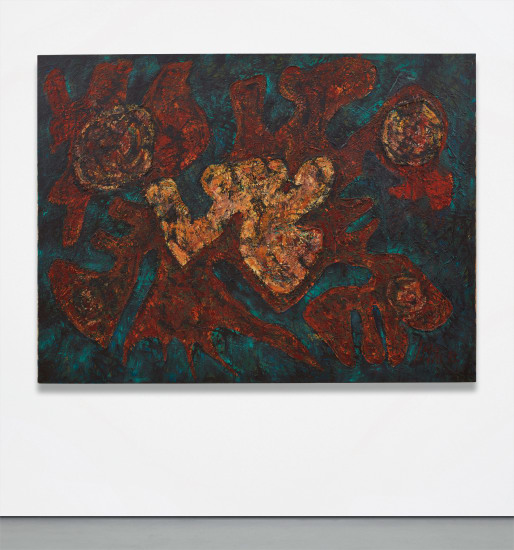

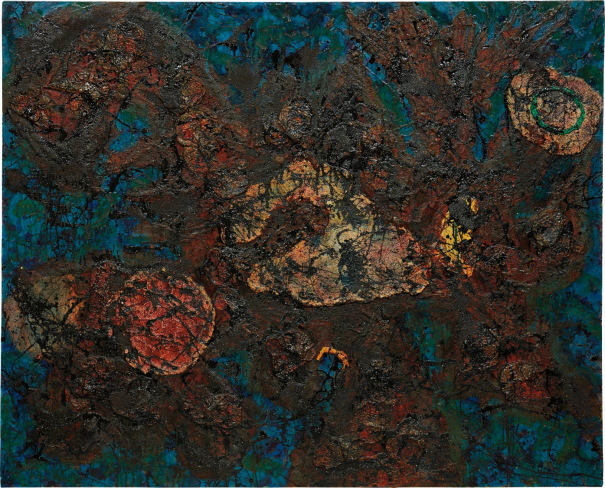


.jpg)
.jpg)
.jpg)
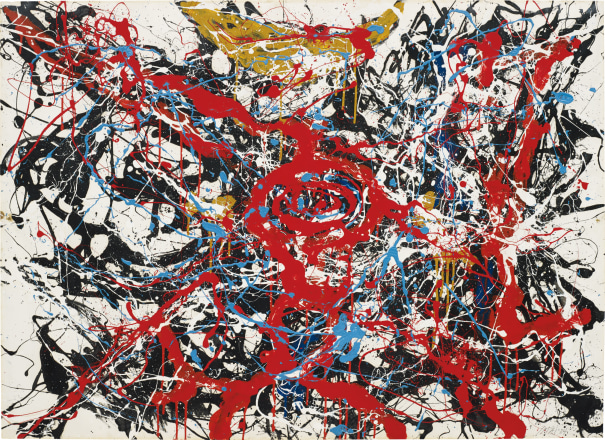


.jpg)
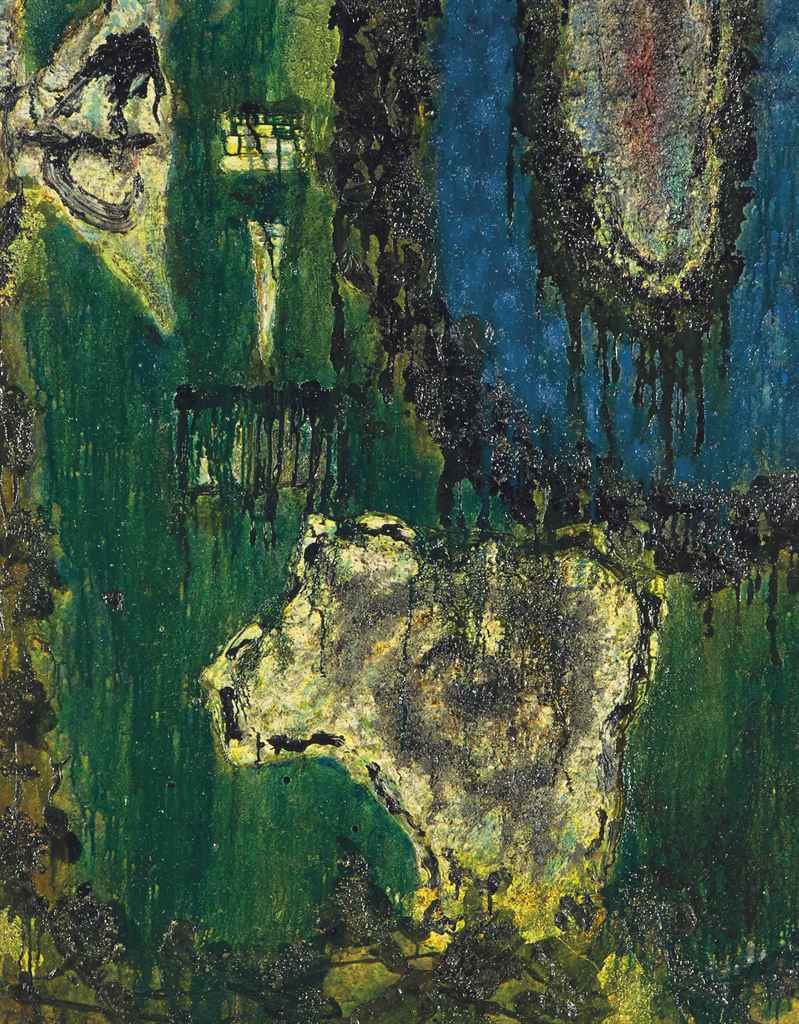
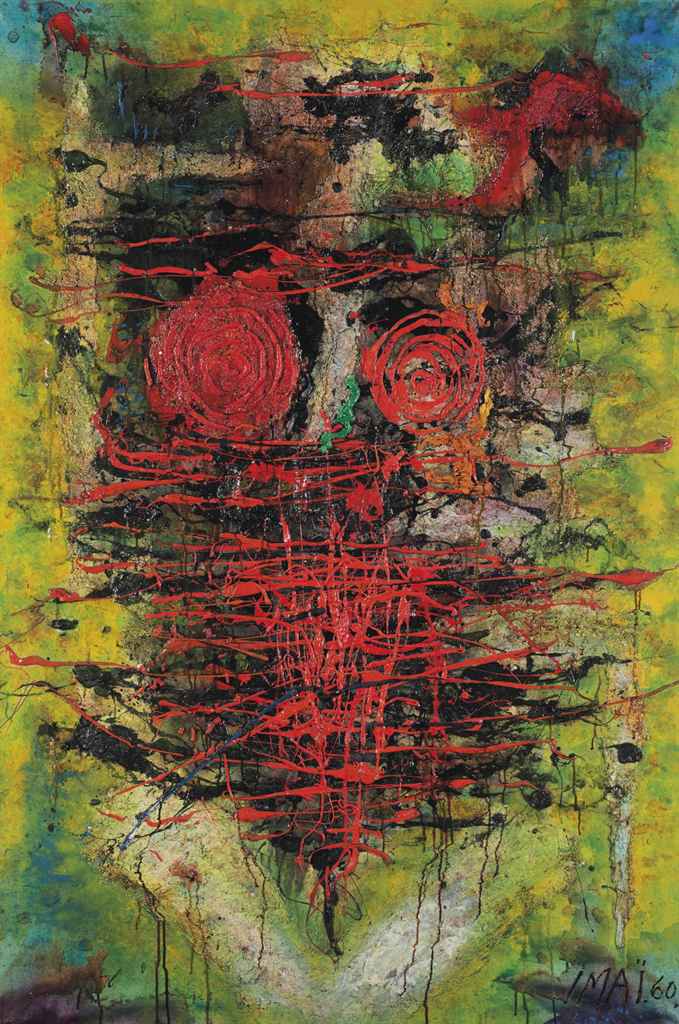
Try LotSearch and its premium features for 7 days - without any costs!
Be notified automatically about new items in upcoming auctions.
Create an alert